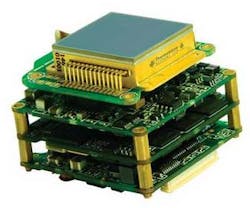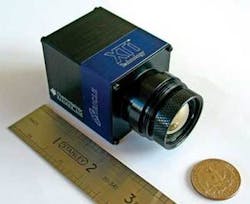NIGHT VISION: Next-generation thermal-IR cameras use shutterless imaging
RICHARD S. SALISBURY
Things have come a long way since 1800 when Sir William Herschel first discovered that an invisible form of light existed beyond the visible spectrum—what we have now come to know as infrared. It was, in fact, a purely coincidental discovery—he was actually trying to measure heat from the visible spectrum.
Since then, infrared (IR) technology has moved forward in leaps and bounds. The first true thermal-imaging systems were developed in the 1950s by Honeywell, Texas Instruments, and Hughes aircraft for U.S. military applications in the Korean War. By today’s standards, these systems were crude, single-element detector devices but with very complex optics and scanning mechanisms. It wasn’t until the late 1980s that more-advanced microbolometer systems started to develop and become attainable for much more widespread commercial uses.
Early cameras used liquid nitrogen or complex refrigeration systems to cool the IR detectors to several hundred degrees below freezing to increase their sensitivity to the incoming heat from the target. The lack of portability and prohibitive price of these systems ensured that for many years they remained in the realm of defense, critical applications such as aerospace, or in the hands of industry consultants. But as the technology developed, so did the performance of detectors, cameras, and software systems—with concurrent reduction in entry-level price.
Today, each successive development in uncooled-microbolometer technology has added more features and performance to the cameras, which have become progressively smaller, lighter, and more energy efficient. Now the industry is at a point at which the only limiting factors to further reducing the camera size and complexity are the physical size of the most fundamental elements of any thermal imager: the IR detector and the mechanical components.
Improving FPA detectors
The technology advance from a single-element detector to a multielement focal-plane array (FPA)—which resembles the charge-coupled-device (CCD) chip in a conventional digital camera—has enabled camera designers to remove the complex mechanical scanning systems of moving mirrors, prisms, and polygons of the earlier single-element detector designs that were used to create a two-dimensional image. However, unlike the visible-light CCD, IR FPAs respond to heat rather than light, and are constrained by the need to insulate each element in the FPA from its neighbor, and by the fact that the very energy falling onto each element affects its performance (see Fig. 1).As the heat from adjacent electronics or the temperature of the case varies, or as the heat from the target in view itself varies, the detector gain and level values will intrinsically drift away from stability and cause nonuniformity in the image. Even worse, these heat sources cause noise that increases with time. To correct the nonuniformity, a mechanically operated calibration shutter mounted immediately in front of the detector is raised—like a flag or wink—into position in front of the detector to block off all incoming energy from the target and allow the detector to be recalibrated against a fixed source. This recalibration is required at intervals varying from a few seconds to a few minutes, depending on the factors that cause detector drift at any time.
Reducing thermal effects
Manufacturers of infrared detectors have tried to reduce the amount of detector drift by stabilizing detector temperature with either a thermoelectric (Peltier effect) heater/cooler or a microrefrigerator finger mounted directly onto the detector. However, both these mechanisms offer only a partial solution within narrow operating conditions and with high consumption of the all-important power budget of the imaging system.
Until recently, a significant and seemingly impossible goal remained for all those involved in the thermal-imaging industry: eliminating the need for the one essential moving component of an IR camera—the shutter. Since the dawn of solid-state FPA-based thermal imaging, shutterless operation has been considered the “holy grail” of the industry.
Current-generation FPA-based cameras require frequent shuttered calibration and blanking off of the incoming signal with the “shutter” or “flag” to render the observer “blind” to the scene for several seconds at a time. In critical situations such as target tracking, on-line machine vision, head-up displays, or weapon-based applications this complete obstruction to vision can be inconvenient and at worst, fatal. This shuttered or blinkered approach—though quite effective—has several obvious and major problems associated with it.
First, when the shutter closes for the detector to calibrate, the user can see nothing. Second, this calibration process can take up to several seconds and can happen frequently, depending on the camera and its operating environment. In situations in which the user needs to see to survive (such as when operating a vehicle or seeing hostile personnel in complete darkness), shuttered operation is unacceptable. But because the industry believed that a shutter was unavoidable, the compromise of regular loss of vision had been accepted as part of the technology.
Steps to shutterless operation
With the escalation of global military activity in the war against terror, improved night-vision solutions are being sought to assist the forces. To work reliably in combat conditions, all equipment must be ruggedized and durable. In addition, the elimination of any unnecessary moving parts reduces unreliability and fatigue over time. Not only does removal of the shutter reduce these negatives, but overall system weight is reduced and the unit requires less power-important factors in the increasing use of smart unmanned aerial vehicles, in which size, weight, and power consumption are critical. Another issue is the actual acoustic noise associated with opening and closing the shutter, a problem that can “make or break” covert or undercover missions.The first step in this innovation came from an earlier camera that introduced an amorphous-silicon detector, which eliminated the thermoelectric heater-cooler or microrefrigeration from the device, allowing the detector to drift freely from a stabilized or fixed operating temperature. Thermoelectric (T/E) heater-coolers can only stabilize the detector over a relatively narrow operating ambient, and the wider the ambient control required, the more power is consumed. Accordingly, detectors only maintain their quoted performance within the controlled temperature range of the detector and once the detector starts to move away from its control point, picture quality and performance suffer while still consuming maximum power. The amorphous-silicon technology, however, has three immediate benefits: instantaneous operation, reduced power consumption, and reduced cost.
First, amorphous silicon reduces the time to obtain an image from the power-on initiation of the camera because the detector does not need to be heated or cooled to reach its operating temperature, so performance is almost instantaneous. This is a significant benefit in most military applications in which time to image can mean the difference between life and death.
Second, camera power consumption is significantly reduced. For all handheld devices, operating power consumption is a critical factor. The power consumption of T/E heater-coolers increases as operating ambient temperature rises or falls from the set point, typically 30°C; outside the normal control envelope, power consumption is maximized and detector stability is lost.
Finally, cost and complexity are reduced. Removing the T/E heater-cooler reduces manufactured cost of the detector and eliminates a potential cause of failure and repair.
The next step in the evolution of MIRICLE was to take the methodology used in operating the camera without a T/E heater-cooler and advance it to eliminate the calibration shutter itself. This required a fundamental understanding of the way the output of individual detectors varied and the factors affecting the performance of one element with respect to another. With the use of XTi technology, the processing electronics eliminate the need for a shutter and enable “always-on” uninterrupted image viewing for the user. The elimination of the shutter from the uncooled or stabilized thermal camera presents huge opportunities for night vision and thermal imaging in all of its diverse application sectors (see photo at top of this page).
Richard S. Salisbury is managing director of Thermoteknix Systems, Teknix House, 2 Pembroke Avenue, Waterbeach, Cambridge, England CB25 9QR; e-mail: [email protected]; www.thermoteknix.com.



